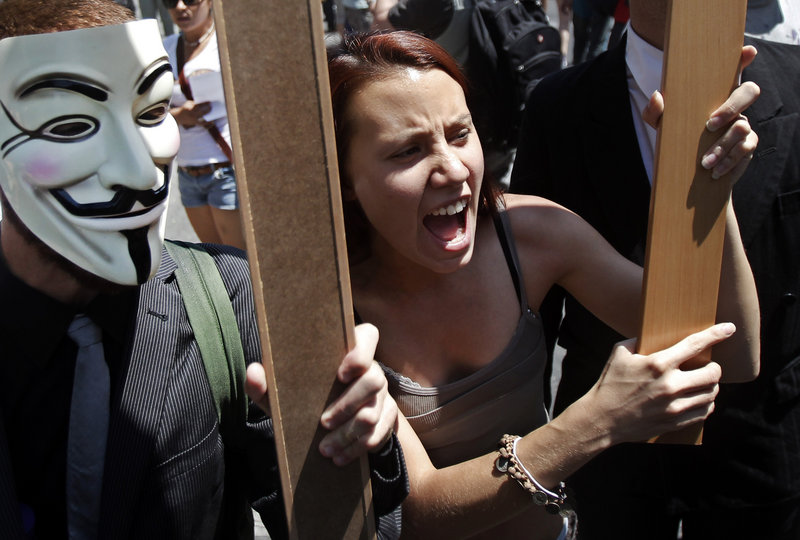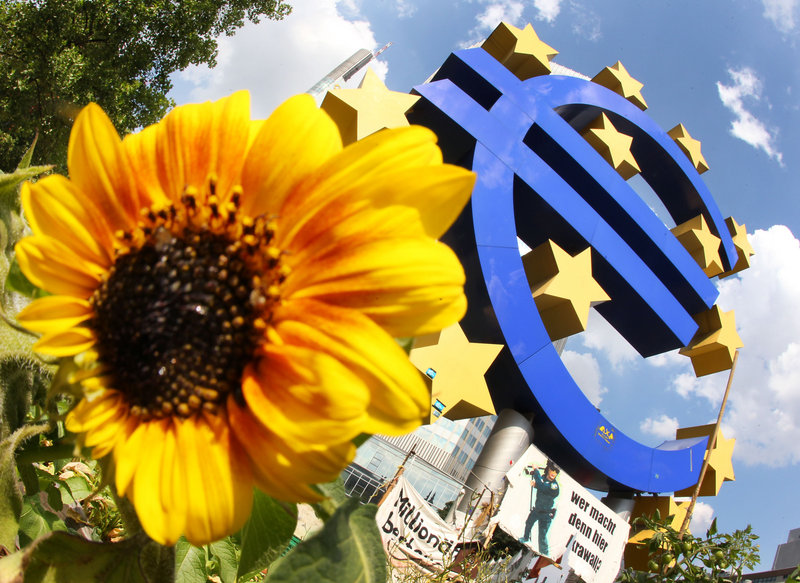WASHINGTON – The global economy is in the worst shape since the dark days of 2009.
Six of the 17 countries that use the euro currency are in recession. The U.S. economy is struggling again. And the economic superstars of the developing world — China, India and Brazil — are in no position to come to the rescue. They’re slowing, too.
The lengthening shadow over the world’s economy illustrates one of the consequences of globalization: There’s nowhere to hide.
Economies around the world have never been so tightly linked — which means that as one region weakens, others do, too. That’s why Europe’s slowdown is hurting factories in China. And why those Chinese factories are buying less iron ore from Brazil.
As a result of this global economic slowdown, the International Monetary Fund has reduced its forecast for world growth this year to 3.5 percent, the slowest since a 0.6 percent drop in 2009. Some economists predict the global economy will grow a full percentage point less.
For now, few foresee another global recession. Central banks in China, Britain, Brazil, South Korea and Europe have cut interest rates in the past month to try to jolt growth. European leaders have begun to focus more on promoting growth, not just shrinking debt and cutting budgets.
The Chinese government, in particular, is expected to do what it takes to protect its economy from deteriorating too quickly. And despite their slowdowns, China and India are still growing at rates America and Europe can only imagine.
But many economists say European policymakers aren’t moving fast enough to strengthen European banks and ease borrowing costs for Italy and Spain. They fear the global impact if Europe’s economy deteriorates further.
Stock prices in the United States and elsewhere are fluctuating almost daily depending on the outlook for a resolution of Europe’s debt crisis.
Around the world, sales at companies ranging from automakers to technology companies are falling. Advanced Micro Devices, a California-based maker of computer chips used in everything from slot machines to smart cameras, says revenue likely dropped 11 percent in the second quarter because of weaker-than-expected sales in China and Europe.
At Jagemann Stamping Co. in Manitowoc, Wis., sales to Europe have dropped more than 10 percent from a year ago. The company makes metal parts for auto companies and other customers.
It’s still enjoying strong sales in the United States, so it hasn’t had to cut workers because of falling business in Germany and the Czech Republic.
“What it does is slow our new hiring,” says company president Ralph Hardt.
One growing concern about the global economy is there’s little margin for error: Unemployment is already at recession levels in Europe and the United States.
The United States, by far the world’s biggest economy, has long pulled the global economy out of slumps. Now it needs help.
Three years after the Great Recession officially ended, the American economy can’t maintain momentum. For the third straight year, growth has stalled at mid-year after getting off to a promising start.
Unemployment stood at 8.2 percent in June — the 41st straight month it’s been above 8 percent.
Americans spent less at retail businesses for a third straight month in June, the longest losing streak since the recession. Economists are downgrading their estimates of economic growth in the April-June quarter. When the government releases its first estimate Friday, many think it won’t even match the first quarter’s sluggish 1.9 percent annual pace.
The global slowdown is squeezing U.S. exports, which have accounted for an unusually large 43 percent share of U.S. growth since the recession officially ended in June 2009.
Consumer confidence has fallen four straight months in the face of scant hiring and weak economic growth. U.S. companies are nervous about the threat of tax increases and spending cuts that are scheduled to kick in at year’s end unless Congress breaks a deadlock. The IMF has warned of a spillover to the rest of the world if the U.S. economy falls off the so-called fiscal cliff.
Europe’s obstacles are even more severe. It’s faced with crushing government debts, struggling banks and scant economic growth. Unemployment in the 17 countries that use the euro is 11 percent, the highest since the euro was adopted in 1999.
Greece, Portugal, Italy and Spain are in recessions. Germany and France are faring better, but both are likely to grow more slowly this year than America.
French retail giant Carrefour SA — the Walmart of Europe — says its sales fell in the second quarter amid a slowdown in its core markets in Europe.
Italy’s Fiat lost nearly $260 million in Europe the first three months of the year. French carmaker PSA Peugeot-Citroen plans to slash 8,000 jobs in France and close a major factory. Europe’s banks are stuck with bad real estate loans and shaky European government bonds.
The European Central Bank has made massive amounts of money available to Europe’s banks at cheap rates to try to revive lending. But borrowing by many businesses and consumers remains weak because they are uncertain about future income.
Many fear that Greece and perhaps other countries will default on their debts and have to abandon the euro currency, which could ignite financial chaos across Europe.
A summit of European leaders last month produced some agreements that helped calm markets for a few days. But optimism faded as investors recognized that governments are still saddled with big debts and banks with bad loans. And that Europe itself still faces the threat that growth will stall and the euro currency alliance will collapse.
The European Commission predicts the 17-country eurozone economy will shrink 0.3 percent this year. Many economists fear it could be worse.
In the latest wallop to the global economy, China said last week that its economic growth fell to a three-year low. The world’s second-largest economy grew 7.6 percent in the April-June quarter compared with the same quarter last year. That was the slowest growth since early 2009.
Countries like China need fast growth to serve growing populations and millions of people leaving farms to seek work in cities.
Chinese growth has decelerated for eight straight quarters. That’s the longest slowdown in records dating to 1992, according to Yu Bin, a government researcher.
The slowdown is partly deliberate. In 2010 and 2011, Chinese officials raised interest rates and took other steps to tame inflation and cool an overheated real estate market.
“In today’s interconnected world, we can no longer afford to look only at what goes on within our national borders,” IMF Managing Director Christine Lagarde said earlier this month.
“This crisis does not recognize borders. This crisis is knocking at all our doors.”
Send questions/comments to the editors.




Success. Please wait for the page to reload. If the page does not reload within 5 seconds, please refresh the page.
Enter your email and password to access comments.
Hi, to comment on stories you must . This profile is in addition to your subscription and website login.
Already have a commenting profile? .
Invalid username/password.
Please check your email to confirm and complete your registration.
Only subscribers are eligible to post comments. Please subscribe or login first for digital access. Here’s why.
Use the form below to reset your password. When you've submitted your account email, we will send an email with a reset code.